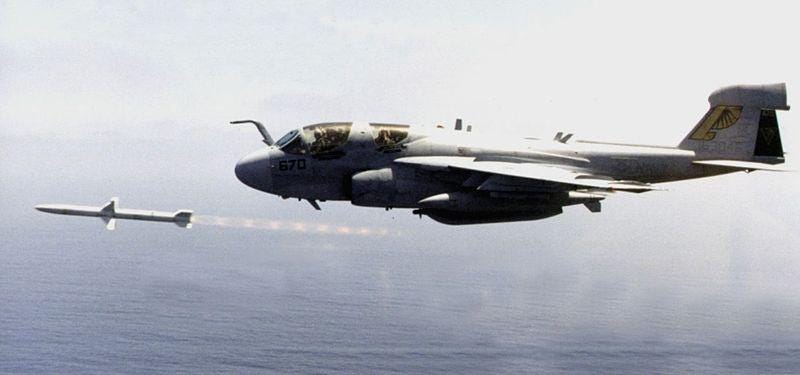Ukrainian aircraft are firing American-made AGM-88 High-Speed Anti-Radiation Missiles at Russian air-defenses in Ukraine. It’s an unexpected development, considering that the HARM normally isn’t compatible with the Soviet-designed MiG-29 and Su-27 fighters and Su-24 and Su-25 attack jets that the Ukrainian air force operates. But it’s possible to guess how the Ukrainians and Americans have made the 800-pound, radar-seeking missile work.
Oleksii Reznikov, Ukraine’s minister of defense, back in July teased the country’s acquisition of anti-radiation missiles. But the first evidence of American HARMs in Ukraine came Sunday, when photos circulated online depicting wreckage of a missile somewhere in Ukraine—wreckage with the distinctive stenciling of an AGM-88. More photos followed Thursday.
The photos sparked widespread speculation. Since no air force ever has integrated the HARM on a Soviet plane type, some observers wondered aloud whether a NATO ally of Ukraine fired the missiles. That always was unlikely, of course, as NATO—while a strong supporter of Ukraine—carefully has avoided direct involvement in the Russia-Ukraine war, for obvious escalatory reasons.
Alternatively, some observers pointed out that later models of the Raytheon-made AGM-88, which first entered service in the 1980s, are compatible with ground launchers. Perhaps the Ukrainians had cobbled together some kind of improvised truck-launcher for older HARMs. On Monday, U.
S. Undersecretary of Defense for Policy Colin Kahl ended the speculation. The Ukrainian air force was firing HARMs that the administration of U.
S. President Joe Biden transferred to Ukraine under Biden’s “presidential draw-down authority,” which allows him to dispatch overseas surplus U. S.
weaponry. “We’ve included a number of anti-radiation missiles that can be fired off of Ukrainian aircraft that can have effects on Russia radars and other things,” Kahl said . “So there are also things that we’re doing to try to make their existing capabilities more effective.
” Kahl even hinted at which of Ukraine’s roughly 100 remaining front-line warplanes are carrying the 14-foot anti-radiation missile. Kahl noted speculation that Ukraine quietly has been acquiring—or at least seeking to acquire—second-hand MiG-29s from NATO countries. “A lot was made about the MiG-29 issue several months ago,” Kahl said.
“Not very much has been noticed about the sheer amounts of spare parts and other things that we’ve done to help them actually put more of their own MiG-29s in the air and keep those that are in the air flying for a longer period of time. ” The twin-engine, single-seat, supersonic MiG-29 is the Ukrainian air force’s most numerous type. Even taking into account wartime losses, it’s possible Kyiv still has 50 or more flyable MiG-29s.
A MiG-29 never has been photographed carrying a HARM, but aspects of the weapon’s design make integration possible. In U. S.
service, the HARM normally functions as part of a wider system for the so-called “destruction of enemy air-defenses” mission, or DEAD. U. S.
Air Force F-16s—specifically, the 200 or so Block 50 models of the classic fighter—are the primary HARM-carriers. The F-16s also haul HARM Targeting System pods, which pack sensitive radiation sensors for pinpointing the locations of enemy air-defense batteries. The HTS pod transfers targeting data to the missile, which flies at Mach two as far as 80 miles and strikes the target with a 200-pound fragmentation warhead.
It’s a complex task integrating the whole HTS with a particular airframe. You’ve got to add wiring with a digital bus for data-transfer and a dedicated HARM Attack Display in the cockpit. Plus, the airframe has to have the HARM’s LAU-118/A launcher rail.
But there’s a simpler approach. The AGM-88 includes a special mode—called “HARM as sensor”—whereby the missile uses its own radiation-detecting seeker head as its main cueing sensor, rather than relying on the HTS pod. It’s a less accurate method of targeting, but it also requires less integration.
To make it work, you just need the launcher rail, the wiring and the attack display in the cockpit. No special sensor pod. It’s not hard to imagine American technicians remotely assisting Ukrainian engineers to add the HARM gear as the latter rebuild their aging MiGs for the DEAD mission.
Actually using the missile in combat is straightforward. When the missile senses a radar, an icon appears on the cockpit display. The pilot slews a cursor to the icon and pulls the trigger.
A minute later, the missile strikes its target, probably. Two hundred pounds of explosives peppering radar dishes, missile launchers and control vans. .
From: forbes
URL: https://www.forbes.com/sites/davidaxe/2022/08/11/ukrainian-jets-are-firing-american-anti-radar-missiles/



